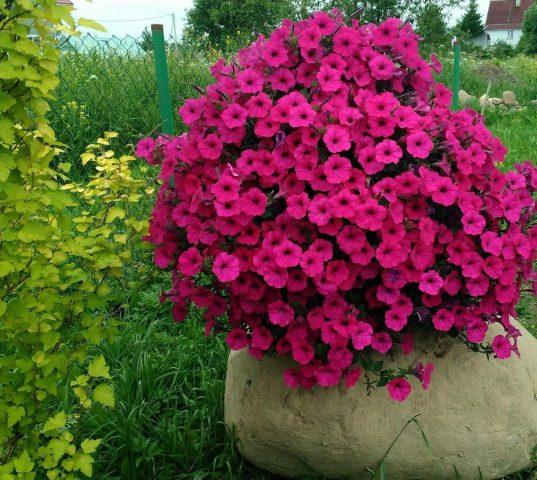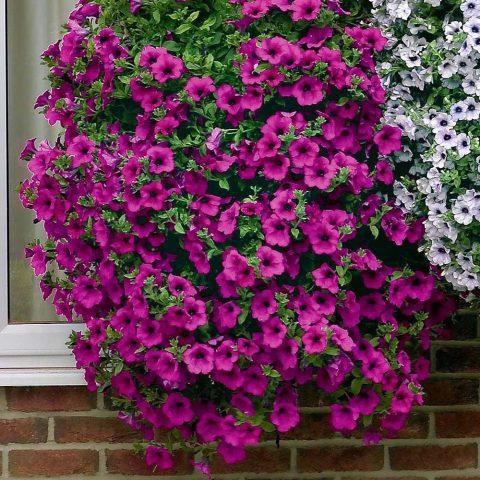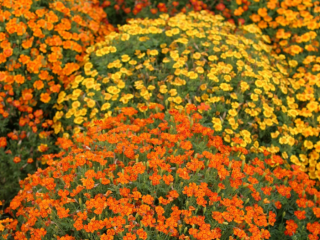Content
Petunia Tidal is a type of herbaceous flowering plant. The culture is represented by heterotic hybrids of a one-year biological cycle with different flower colors and bush shapes. Due to its high stress tolerance, standard agricultural practices and long flowering period, the plant is popular among gardeners and landscape designers.
Characteristics of petunia Tidal
Tidal is an annual herbaceous shrub with abundant flowering, the period lasts from June to September. The plant is unpretentious, grows well in open areas, and can withstand slight shading. Petunia Tidal calmly reacts to temperature changes, prolonged rains, and gusts of wind.
Seedlings resist return frosts down to -30 C, in case of slight freezing, they quickly recover and bloom within the prescribed time period for the variety. The culture is undemanding in terms of soil composition, but develops better on fertile, aerated soil with a neutral or slightly acidic reaction.
External characteristics of Tidal wave petunia:
- dense herbaceous shrub 50-12o cm high, 90-200 cm in diameter with a well-developed root system;
- stems are creeping or erect, with a flexible structure, forming shoots of the second and third order. The shoots are green, with dense fine pubescence;
- leaves are alternate, sessile, entire, lanceolate, light green with glandular hairs;
- flowers are funnel-shaped, 4-12 cm in diameter, double or simple, the calyx is five-parted, formed by densely pubescent petals fused at the base;
- Tidal petunia varieties are presented in white, cream, pink, dark purple, purple, yellow;
- The fruit is a capsule with numerous black seeds.
Traditionally, Tidal petunia is planted in flower beds, flower beds and ridges are decorated. In decorative gardening they are used to create border strips. The hanging plant is used to decorate terraces, balconies, verandas, and flower vases.
Petunia Tidal is propagated mainly by seeds, but cuttings are also possible if it is planted in a container. For the winter, transfer the plant to a room with a temperature no higher than +40 C, in spring, cut 12 cm sections from the middle of strong stems and plant them.
Types and varieties of petunia Tidal
Representatives of the variety are separated into a separate group - giant petunia. They are classified as ampelous, bush and cascading plants. All varieties are profusely flowering, with flexible stems resistant to mechanical damage. Petunias are simple or double in flower shape, multiflora or grandiflora in size; there are no small-flowered varieties in the Tidal group.Below are popular garden hybrids for hanging and open ground cultivation.
Petunia Tidal wave Silver
Tidal Wave Silver is the largest representative of the multiflora group in terms of crown volume. Stems are erect, up to 60 cm long, with intensive branching. The bush grows up to 2 m in width, displacing all nearby lower plants. It is recommended to take this factor into account when planting. The flowers are 5-7 cm in size, white, light pink, lavender. Petunia is suitable for hanging cultivation; Tidal Silver is planted in large containers for decorating a garden or an open veranda.

Flowering continues from June until the first frost
Petunia Tidal wave Red Velor
Tidal wave Red Velor is a popular variety among gardeners in the Central and Middle Zone. Characterized by a high level of stress resistance. The growing season is not affected by sudden changes in temperature, lack of ultraviolet radiation, or high air humidity. It blooms until the first frost and calmly withstands sub-zero temperatures both at the beginning and at the end of the season. Tidal Red Velor is a cascading petunia with creeping stems. It is grown not only in a flower bed, but also in a hanging pot for vertical gardening. The length of the stems is up to 1.2 m, the width of the bush is 1-1.5 m. The branching is intense, the flowers are 5-6 cm wide with a dense, small edge.

Red Velor is represented by red, purple, lilac buds
Petunia Tidal wave Cherry
Tidal Wave Cherry is an ampelous, medium-sized representative of the group with large flowers. The stems are up to 90 cm long, the crown volume is 1.5 m. In open ground, the bush rarely exceeds 40 cm in height and 60 cm in width.It is more often used to create borders or decorate rock gardens. The flowering period is from June to the end of September. In warm regions until mid-October. Flowers up to 12 cm in size, single or collected in 2-4 pieces. into thyroid inflorescences.

Cherry is characterized by dark pink or light purple petals
Petunia Tidal wave Purple
Tidal Wave Purple - a medium-sized variety, stems 80-90 cm long, branched, creeping type. In a flowerbed it is used as a ground cover plant, in a hanging flowerpot - for vertical gardening. A variety with bright purple or violet flowers, 5-7 cm in size, densely spaced. The aroma is bright, subtle, more pronounced in the evening.

Flowering is abundant and long from the first summer month until October
Petunia Tidal wave Hot Pink
Tidal wave Hot Pink - a plant with a height of 40-55 cm, the parameter depends on the planting density. The more space around the variety, the more it grows in width, forming a carpet densely covered with buds. Flowers up to 5 cm in size, bright pink. A variety with intensive growth and the ability to quickly regenerate after possible damage.

The buds bloom in early June, Tidal wave Hot Pink retains its decorative appearance until mid-October
Petunia Tidal Shock wave
Without adjusting the length of the stems, the Tidal shock wave plant can grow up to 80 cm in height and 1.2 m in width. You can pinch the tops of the shoots before the budding period, then the variety will form a dome-shaped dense crown. The variety has all the positive characteristics characteristic of this group: stress tolerance, resistance to infections.The variety is interesting due to the variety of petal colors; there are representatives with purple, blue, violet, and white inflorescences. This is the only variety of Tidal petunia in which the color can be double in the contrast of white and purple, blue, violet.

Tidal Shock wave is part of the multiflora group, flowers with a diameter of 4-6 cm
Advantages and disadvantages
Petunia Tidal is very popular among gardeners in the temperate and subtropical zones.

The crop is suitable for hanging in any climate zone.
Pros:
- abundant, long-lasting flowering;
- in Tidal varieties the buds open almost simultaneously. This happens 14 days earlier than other varieties of petunia;
- the stems are flexible and do not break from the wind;
- stress resistance;
- high survival rate of seedlings;
- ease of care;
- variety of flower colors;
- persistent, pleasant aroma;
- strong immunity.
Minuses:
- All representatives are hybrids, so the seeds are not suitable for further propagation.
How to grow Tidal petunia from seeds
In temperate climates, the plant is grown as seedlings; in the South, it can be sown directly into the ground. But it will bloom later, so it is better to get seedlings in advance. Planting material does not require special preparation; it is sold already treated against fungus.
Technology for planting Tidal petunia for seedlings:
- Planting is carried out in containers with fertile substrate, the soil is moistened and the seeds are scattered randomly on the surface.
- The grains are very small and do not need to be covered with soil. The container is covered with film or glass on top to maintain moisture.
- Petunia Tidal sprouts on the 14th day, the covering material is removed and optimal humidity is maintained using an aerosol method.
- Containers are placed in a well-lit place with a temperature range of +18-220 C.

After 30 days of growing season, the seedlings are planted in separate containers
Adapted seedlings in a permanent place do not get sick and immediately begin to gain green mass.
Growing Tidal petunia from seeds in open ground is no different in technology. Planting material is sown on the surface of the prepared bed and covered with film overnight. After germination, the covering structure is completely removed.
When to sow Tidal petunia
To obtain planting material under indoor conditions, seeds are planted in March. Petunia Tidal is sown in open ground approximately in the second half of April. Seedlings are planted in a flowerbed in a temperate climate zone in mid-May, when the weather is stable. You can place seedlings in flowerpots in April, and take them out onto the plot or balcony in May.
Landing rules
The soil is prepared on the day the plant is placed on the site.
How to plant Tidal petunia correctly:
- The soil is dug up and plant debris is removed.
- At 1 m2 add 5 kg of compost or humus, 1 tbsp. l. nitrophoska, 3 tbsp. l. ash. Embed into the soil to a depth of 10-15 cm.
- Water generously and leave for a couple of hours.
- Plant petunia with a lump of earth.
- They make holes and place the plants at the same depth as they were during preliminary cultivation.
Petunia Tidal does not respond well to thickened plantings, so the interval between seedlings in linear placement is left at 20-50 cm, depending on the variety.
For hanging cultivation, containers with a volume of at least 25-30 liters are used. The bottom must have holes and a drainage layer. The soil is used ready-made; it can be bought at any specialized store, or you can make a mixture yourself from humus, sand, turf soil and peat in equal proportions.
Features of care
Watering is oriented towards seasonal precipitation. The root circle should not be allowed to dry out. During drought, 6 liters per root twice a week is sufficient. The main care consists of feeding:
- Prepare the product with 10 liters of water: 30 g of urea and Agricola-7 each, water the petunia 14 days after placing it in the flowerbed, consumption - 2 liters per 1 m2.
- The next fertilizing with potassium sulfate (10 l/60 g) is given at the time of budding - 3 l per 1 m2.
- Two weeks later, when the buds bloom, fertilize 30 g of nitrophoska, urea, “Flower” product per 10 liters, water at the root at the rate of 3 liters per 1 m2. The procedure is repeated at intervals of 15 days.
Loosening is not relevant for petunias. Weeds are removed by the roots as soon as they appear. Maintain a decorative appearance by removing dry leaves (if any) and faded flowers. At the end of the season, the remains of the bush are completely removed from the site.
Conclusion
Petunia Tidal is a plant with a long flowering period. A herbaceous shrub with flexible branched stems completely covered with single, densely arranged buds. Available in a variety of colors from white to dark purple. Plants are suitable for growing in a flower bed or in a pot. Used in decorating a garden, plot, terrace, balcony.








